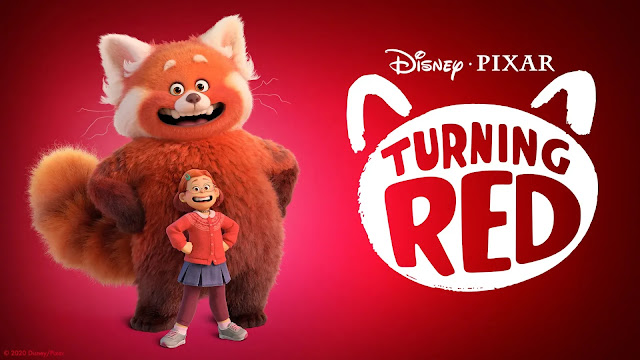
Unfortunately, Turning Red will not be released across cinemas on a large scale, for many moments of laughter, enthusiasm and suspense. While modern Pixar productions have welcomed adults with open arms (especially people who have grown up to watch the original studio films), their recent films do not shy away from being directed at younger audiences, both in story and graphic terms, without risking the essence and sense of humor that makes these films so special and fascinating. The film is directed by Dumi Shi, whose short film Bao premieres "Incredibles 2" in cinemas, and is taking place in Toronto, and is about a Chinese-Canadian teenage girl in adulthood who has complications in every respect, whether personal, cultural or magical. It also results in a fond and fun story about family and friendship, with an example of growth, which is delivered in a way full of inspiration and creativity that Pixar needed some time ago.
The story takes place in 2002, where 13-year-old Millen Lee (Rosalie Chiang) just managed to find a balance between school excellence, spending time with her group of close friends, and helping her mother Ming (Sandra Oh) oversee Toronto's oldest Chinese temple. Even before we meet our young, energetic heroine, we hear her initial voice comment full of determination and courage, a confidence tested when, one morning, she wakes up to find herself turned into a giant red panda. And after feeling like she's like a blown monster, she's cascading around her mom Ming and dad Jin (Orion Lee) drowning in anxiety as she tries to move her changing body. But things soon get complicated when Meng turns out not to be entirely surprised by Milne's seemingly emotionally motivated transformation. Apparently, this particular problem applies to the family.
The stakes in Turning Red are smaller and more personal than one might expect. There's no doubt that Milne's condition leads to family conflicts, where her mother tries to help her hide it (and help restrain her feelings so that she doesn't publicly release her condition like the Hulk). But this tension quickly interwoven with the story of Milne and her three girlfriends trying to attend a live and live concert of their favorite band, and this scenario conflicts with Milne's unexpected changes, highlighting themes that become chaotic, such as the high expectations of immigrant families, the relationship between a mother and her daughter, the adaptation to the gridlock of emotions as a teenage girl, and growing up with friends who are confused and hormuddy.
And after a while, another two-mile character comes the red panda to represent all this stuff and more, but the movie never drowns itself with metaphors about all this. Thanks in large part to the very obvious visual style, which makes every moment (and every metaphor) wonderful fun. While modern Pixar films such as The Good Dinosaur, Soul and Toy Story4 tend to be more realistic environments, Turning Red uses the computer-generated graphics style that the studio is known for with a close-to-anime orientation, with fast-paced snapshots of emotions, at a time in which the characters seem to be living.
The characters have great details, too. Milne's girlfriends are diverse, not only ethnically, but also in design and character. There's her South Asian boyfriend Priya (Maitryi Ramakrishnan) who speaks more in her body language than words. And her short, hyperactive girlfriend from Korea, Abby (Hayein Park), who is an indefatigable movement. Then there's her skinny, white best friend Miriam (Ava Morse), whose parents give her more freedom to act than her three Asian friends, but she seems to understand two miles more than the others (as in any friendship, where you have favorite friends, but you have your best friend). Each of them is oddly perfect for a story about 13-year-old girls. Although each has a different length and body, they all fit together as a group, and their fears and weaknesses seem to fade when they are together.
Their clothes also feature unique and bright colors that allow them to feature in most scenes, making them similar to the different emotions of Inside Out, although this resemblance may not be a coincidence. Not only did Milne's girlfriends calm her down (and sometimes make her nervous by mistake), but Turning Red also bears a resemblance to Inside Out: It is about the physical pressures of development as much as self-reconciliation and giving way to complex, contradictory and unpleasant feelings as well.
Milne's family enjoys the same amount of detail and dynamism as her friends. Her father, the optimist Jin, speaks with a little more Chinese accent than Ming, who seems to be more interested in resembling others than he is, and this is also one of the reasons why Ming hopes to keep Milin's panda problem hidden, given her cultural origins, and the reactions she can receive from non-Chinese characters (she rarely seems to give Milin's girlfriends enough confidence). But the details of the dynamic relationship between a mother and her daughter are what is most evident in the film. The two characters have markedly different designs, but when the film begins, their dialogues and even their body movements reflect each other. This establishes a story in which they become reflective of each other in both public and hidden ways. Another interesting detail is the fact that Ming nicknamed Milin "Mi Mi," which in Chinese is synonymous with the meaning: The younger sister, while their relationship as mother and daughter is undoubtedly being tested, their bonds of friendship and sense of love and mutual support are also being tested.
All of this might seem casual, either as a film about a girl's maturity or as a story about the struggle of a first-generation immigrant culture, if not for the way every minute in the film seems to set high targets. While some of the quieter and more realistic scenes unfold during the very painful and moving moments, most of the film runs at a very fast pace with the energy of Looney Tune, which sometimes comes immersed in vibrant colors, resembling a scene emerging from Disney's dream of the 1990s. Ludweng Goransson's background music is fun and moving, even helping to tell her own story by combining the influences of Western pop with traditional Chinese music, which peaks in unexpected ways during the rise of the loud, fun and vibrant Turning Red.
Every dramatic transition in the story carries its own vivid music, making the film a great journey full of jokes, but the visual laughs always reinforce the tension and emotion rather than the contrivance. For example, a group of Milne's aunts, who enter the story at a pivotal time, such as Hollywood movie stars, arrive in flashlights, while the Attractive Boys 4-Town (a reflection of pop music in the early 2000s, but with a Korean member to put them in the spirit of the era) is portrayed as stars sunshine. Even Milne's revolutions affect the entire fabric of the film around her, starting to see herself as a brutal nuisance that doesn't deserve to exist, until her friends and family convince her to the contrary.
And most importantly, it's an explicit film about the most embarrassing moment of adulthood, from being ashamed by growing desires, to inexplicable anger, to dealing with physical insecurity, which turns into vivid and imaginative scenes in every corner and turn. There's never a boring moment in Turning Red, because Shi director and co-author Julia Cho links every event and interacts with layers full of meaning, and because everything comes encapsulated with cartoon effects that rely more on expressions than realism, something that modern Hollywood animation sometimes forgets.
Summary
Turning Red (directed by Dumi Shi of Bao) tells a magical transformation story about personal and cultural change, Pixar's funniest and most creative film in years. The film captures the unbridled energy of teenagers, uses pop stars as an immortal window towards adulthood, and tells a story about friendship and family in the most fun and child-friendly way.
